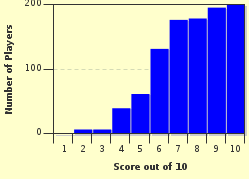Quiz Answer Key and Fun Facts
1. Sometime between May 20 and May 29 in the year 526, an earthquake struck an ancient city in Syria which is often considered one of the early centres of Christianity and remains the seat of a patriarchate in the Eastern Orthodox Church. Which of the four cities referred to as the Syrian Tetrapolis was hit by the earthquake?
2. The deadliest earthquake on record occurred in Shaanxi on January 23, 1556. In what country did this occur?
3. On January 11, 1693 Sicily, Malta and parts of southern Italy were rocked by an earthquake that accompanied the eruption of a famous volcano. Which Sicilian volcano was responsible for this earth-shaking event?
4. At around 10:24am on Saturday, November 1, 1755 an earthquake in the Atlantic Ocean followed by a tsunami and fires almost completely destroyed one of Portugal's major cities. Which city had to be rebuilt in the aftermath of this disaster?
5. Japan, part of the Pacific Rim of Fire, has a long history of earthquakes. The Kanto plain was the scene of destruction from an earthquake on September 1, 1923 which devastated Tokyo and Yokohama, along with a number of other areas. It was so strong that the 93-ton Great Buddha statue at Kamakura, 60 km (36 mi) away, moved almost 2 feet (60 cm). On which of the Japanese islands did this occur?
6. On April 18, 1906 an earthquake caused severe tremors to be felt through most of California, and inland as far as central Nevada. Although many parts of the San Andreas Fault suffered extensive damage, the earthquake is primarily associated with one city, where the damage was most extreme. What is this earthquake usually called?
7. On May 31, 1970 the Ancash Earthquake caused an avalanche of rock, ice and snow to bury the towns of Yungay and Ranrahirca. In what South American country did this occur?
8. The 2004 Boxing Day Tsunami was caused by an earthquake off the west coast of Sumatra, in the Indian Ocean. Which of the following countries was NOT struck by a tsunami generated from this earthquake?
9. On October 8, 2005 an earthquake measuring 7.6 on the moment magnitude scale struck Pakistani-administered Kashmir, and caused extensive damage in Pakistan, western China, Tajikistan, Indian-administered Kashmir and Afghanistan. What two tectonic plates are colliding in this region, causing frequent major earthquakes?
10. What Caribbean country was devastated by an earthquake centred near its capital city on January 12, 2010?
Source: Author
looney_tunes
This quiz was reviewed by FunTrivia editor
bloomsby before going online.
Any errors found in FunTrivia content are routinely corrected through our feedback system.

